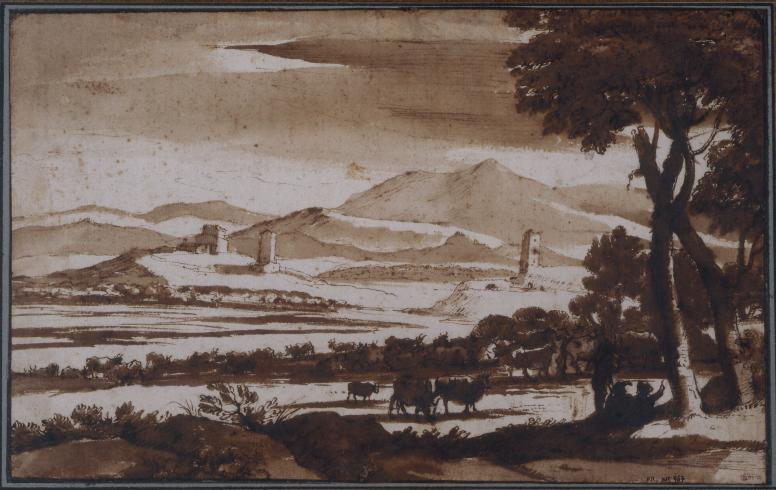Claude, who adopted the name of “Le Lorrain” because of his origins, chose to settle permanently in Rome in 1627. Famous from the beginning of his career, Claude Gellée worked for the most illustrious Roman dignitaries – popes, princes and cardinals – as well as for the King of Spain and foreign nobility. The artist received as much from his adoptive country as he gave it.
Claude quickly chose to become a landscape painter, a field which had become a genre in its own right around 1600. His contemporaries reported that he had the habit of taking trips outside the city, as far as Tivoli, Frascati and Subiaco in order to draw his subjects in situ. His drawings from nature, mainly in bistre wash, form one of the most brilliant chapters in the history of this technique. His excursions were sometimes made with Nicolas Poussin (1594-1665), whose relationship with Claude was friendly and professional. The two artists mutually influenced each other.
In 1633 Claude became a member of the Accademia di San Luca in Rome, and the artist’s life was subsequently entirely devoted to his work, with no further remarkable events.
This beautiful piece of work, which reappeared at the Wellesley sale in 1866, was taken to be a View of Prato Lungo, in the Velletri region. It is, in fact, a depiction of the Tiber Valley, upriver from Rome. The changes of the modern era make it impossible to identify the location more accurately, especially since Claude, as was his habit, had subtly transposed the finely observation subject matter into a poetic and idealised world.
This layout – a river and its banks in the foreground and a series of softly blurred hills in the distance – is a recurring theme in the artist’s drawings, as is the use of washes for pictorial purposes.
Here, the strong contrast between areas of light and shade suggest the heat of a mid-afternoon in summer, when a certain torpor makes all of nature seem lethargic.
Thanks to his drawings from nature in bistre wash, Claude Gellée enriched one of the most brilliant chapters in the history of this technique.
S. R. de B.

City of Paris municipal collection's website
The collections portal can be used to search the collections of Paris’s 14 municipal museums (approximately 336,000 works, including 43,000 belonging to the Petit Palais).
It is also possible to download around 12,000 images of the museum’s works free of charge.
Access the Museums of the City of Paris collections portal
Extern databases
Discover a selection of databases online presenting works from the Petit Palais or documents concerning the history of the museum.

